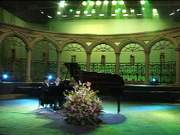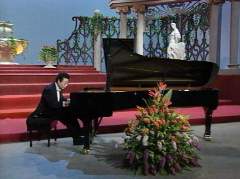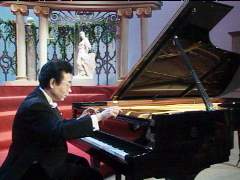 |
|
Chinese Piano Works  |
| CCTV.COM 2002-08-30 15:08:37 |
|
 The teaching and practice of the piano is a phenomenon in China, dating from the beginning of the 20th century, when the instrument was taught by Russian musicians. However, both composition and performance have reached an excellent level in China. The teaching and practice of the piano is a phenomenon in China, dating from the beginning of the 20th century, when the instrument was taught by Russian musicians. However, both composition and performance have reached an excellent level in China.
In November 1934 Russian composer Alexander Tcherenin organized a piano competition in Shanghai for Chinese composers, which brought attention to Chinese artists and their first works. “ Young Herder with a Flute” and “Cradle Song” are two masterpieces by well-known Chinese composer He Luding, which won the first and second prize respectively in the competition. “ Young Herder with a Flute” describes the beautiful scenery of south China with its clouds and rivers, herder and cows, and flute and songs. It was a successful combination of Chinese musical element and western instrument.
The earliest Chinese piano works are compositions by Chinese professors who were the pioneers of musical teaching in China. They were looking for easy pieces for their students. As a result they arranged some folk tunes. The well-known Chinese musician Chen Peixun was the first one who arranged the music of the Guangdong region into piano works.
Both Chinese composers and performers have contributed to the development of Chinese piano works. Ding Shande is a well-known composer as well as an outstanding performer. His first piano recital was held as early as May 11th, 1935. He was the first Chinese musician to give a piano recital in China.
 Though just born in the 1930s, Chinese piano works developed greatly in the 17 years following the founding of the People’s Republic of China. A great number of quality works appeared in a variety of styles. “Days of Liberty” is a piece by Chu Wanghua describing the joys of the people when the Republic was first founded. Though just born in the 1930s, Chinese piano works developed greatly in the 17 years following the founding of the People’s Republic of China. A great number of quality works appeared in a variety of styles. “Days of Liberty” is a piece by Chu Wanghua describing the joys of the people when the Republic was first founded.
During the Cultural Revolution, from 1966 to 1976, Chinese intellectuals and artists were sent to the rural areas. Western music was forbidden at that time except for rare scores by Bach and Czerny. The musicians, being unable to practise music, were forced to work with folk songs and the folklore of remote provinces. These professors and students collected a great number of songs, which were later arranged into piano works when they returned to their position in town.
After the Cultural Revolution, and especially in the 1980s, the younger generation of Chinese composers is more confident in composing works that are more personal, more rooted in Chinese culture. Their repertoire is opening up quite quickly and Chinese music schools contain numerous musicians and performers of an excellent level.
Traditional Chinese music works have always been a major source of material for Chinese piano composers. At the same time they’ve been exploring the best ways to express the Chinese way of thinking and emotions with this western instrument. “Temple Fair” describes the lively scenes of Chinese temple fairs at festival time.
 The popularity of the piano, whose presence in China goes back just 80 years, was first triggered by the enthusiasm of Chinese parents in encouraging their children to have a cultural pastime during the 1980s. They spent heavily during that period, when a piano was equal to the average salary of many years. But those pioneering parents helped nurture a large pool of musical talents, including some international gold medallists. The popularity of the piano, whose presence in China goes back just 80 years, was first triggered by the enthusiasm of Chinese parents in encouraging their children to have a cultural pastime during the 1980s. They spent heavily during that period, when a piano was equal to the average salary of many years. But those pioneering parents helped nurture a large pool of musical talents, including some international gold medallists.
The piano has helped to form bridge of culture between China and the rest of the world. Some of the foreign media even predicted that China would become a nation of pianists in the 21st century.
|
|
Editor: Yang Yang CCTV.com
|
|
|
|
|
|
 |









